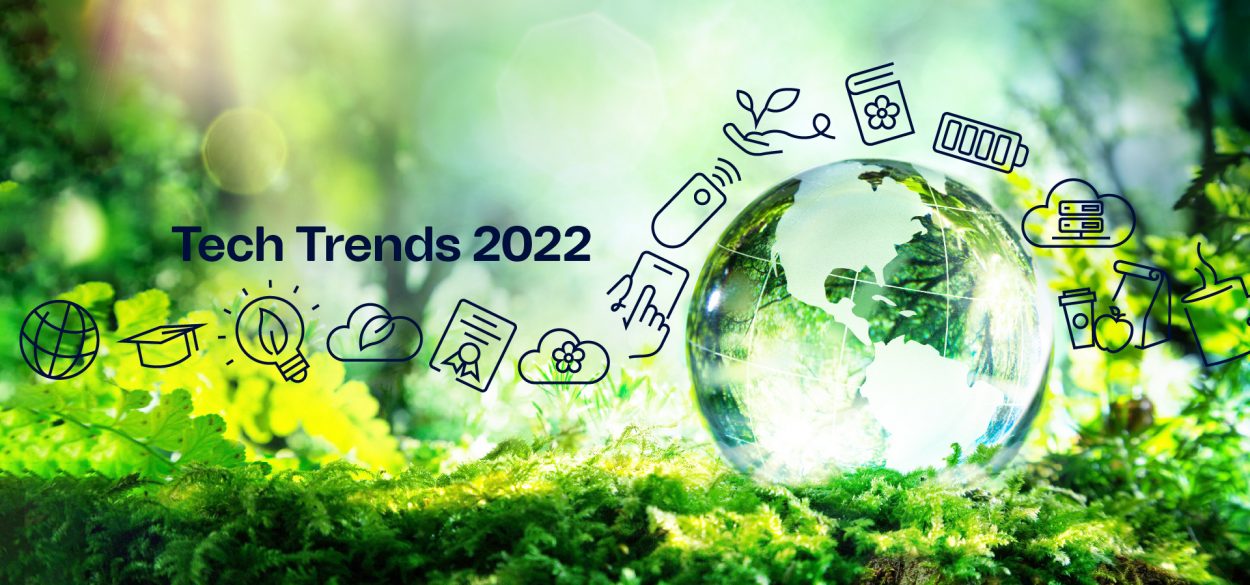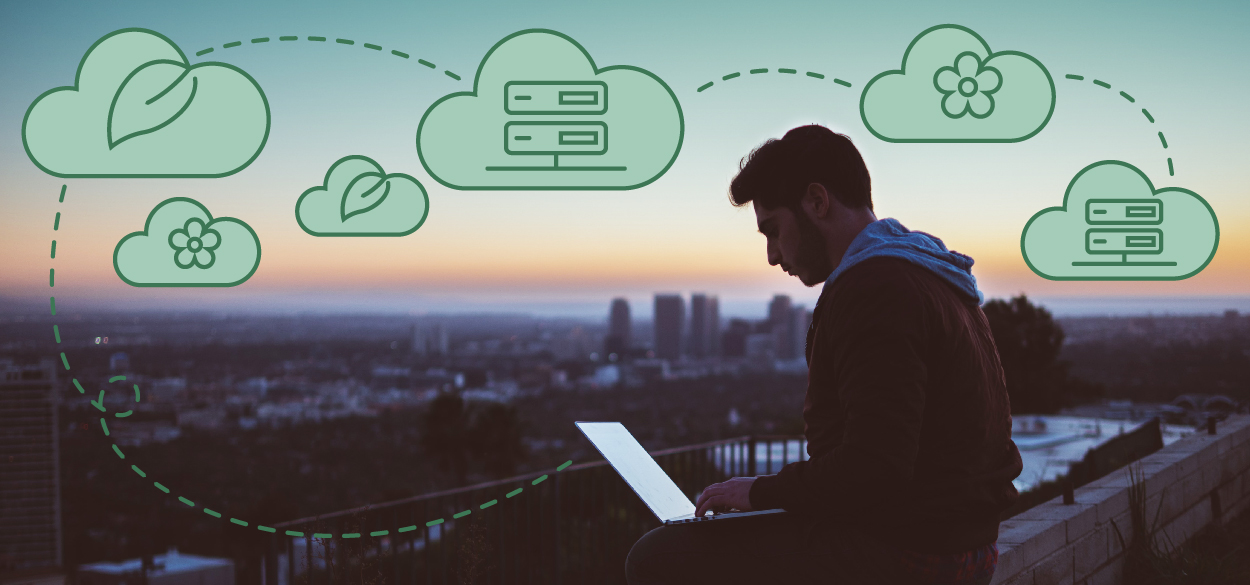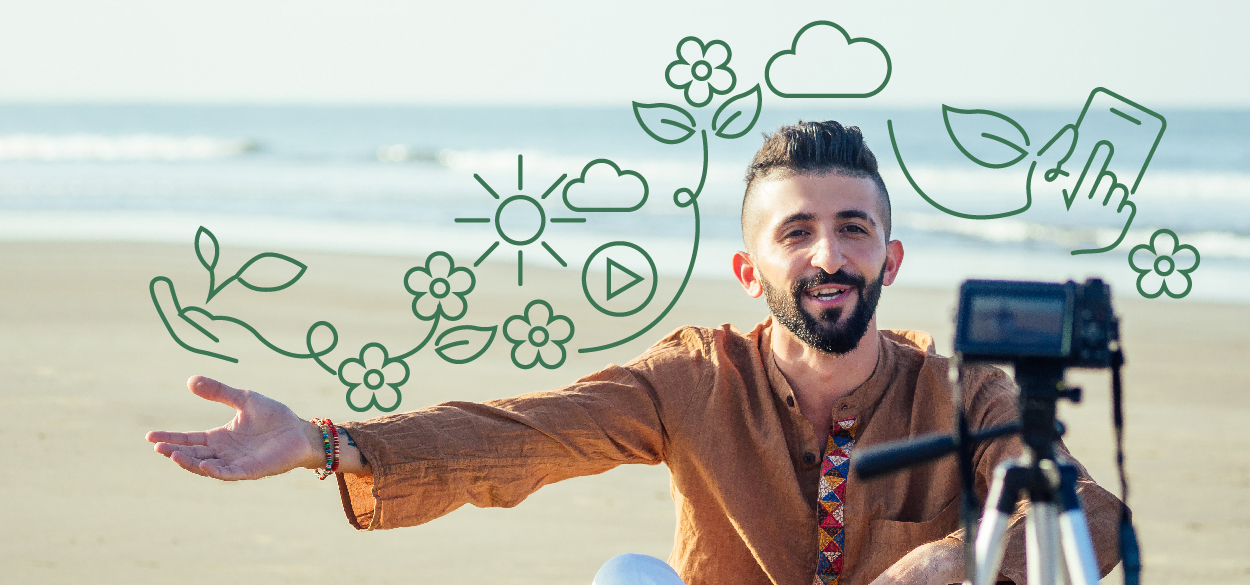
Tech Trends 2022
Five tech trends that will fuel the green transition of society in 2022.
As the climate change alarm bells get louder, technology and digitalisation will come to our aid, predicts Telenor Research in its Tech Trends 2022 report.
Trend 1: Green clouds on the horizon

By Arne Munch-Ellingsen, Senior Research Scientist at Telenor Research.
The immense growth in data usage drives demand for energy. Edge data centres and 5G will help make data transfer more energy efficient.
As the digitalisation of society continues to accelerate, cloud computing has seen explosive growth as the preferred host for web applications and digital services. Amazon Web Service’s quarterly revenues alone have risen from USD 1 billion in 2014 to more than USD 16 billion in 2021. Moreover, mobile devices, excluding tablets, accounts for approximately half of the web traffic worldwide and have increased from 11 exabytes (one billion gigabytes) per month in 2017 to almost 60 exabytes in 2021. Next year, it’s expected to approach the 80 mark. Moving data around requires energy since all network elements involved depend on electricity to function. Today, data centres globally account for more than one per cent of the world’s energy consumption. The good news is that we have a new kid in town who can put a green splash of colour to the darkening cloud energy consumption outlook in 2022.
 “We expect to see Edge computing to take over some of the workloads that have been spinning around in public and private clouds in the coming year. In light of climate change, it’s imperative to investigate how data centres can be more power consumption efficient and how the generated data traffic can be served more efficiently. We predict that 5G networks worldwide will have the capability to do local breakout of data traffic to and from Edge data centres and that new types of applications and services will also find their way to the Edge,” says Bjørn Taale Sandberg, Head of Telenor Research.
“We expect to see Edge computing to take over some of the workloads that have been spinning around in public and private clouds in the coming year. In light of climate change, it’s imperative to investigate how data centres can be more power consumption efficient and how the generated data traffic can be served more efficiently. We predict that 5G networks worldwide will have the capability to do local breakout of data traffic to and from Edge data centres and that new types of applications and services will also find their way to the Edge,” says Bjørn Taale Sandberg, Head of Telenor Research.
An Edge data centre is, from an overview perspective, just compute and networking capabilities located geographically closer to the end user. Edge data centres can be used to host applications and services in the same way public or private central clouds can. Also, the data centres themselves can be made energy efficient in many ways, including utilisation of excess heat and even through sustainable local power harvesting, using solar panels and small windmills.
“We believe that energy efficient Edge data centres reachable from mobile devices over 5G networks will start popping up, at an increasing rate, in 2022. As a result, energy will also be saved in data distribution networks around the globe since part of the data traffic and electricity will be transferred locally only,” explains Sandberg.
Did our predictions for 2021 become a reality? See for yourself in our Tech Trends 2021 report
Trend 2: Big appetite for climate micro-degrees

By Hege Mathea Haugen, Research Scientist at Telenor Research.
Employees are not willing to wait for their companies to get climate friendly. They want to act, and they are impatient to learn how.
A shockwave has swept through the world of learning and altered how we conduct schooling, training, and upskilling. A merger between learning and work was already gradually becoming the norm before Covid-19 swept the globe, but with the pandemic forcing people into home offices and creating an increased need for digital skills, the two have now become virtually inseparable. And just as modern careers require people to upskill continuously, climate change will require people, businesses, and societies to adapt to lifelong learning on knowledge to create and foster greener ways of living and operating. Environmental policy and regulation will also push industries towards greater sustainability in 2022, increasing the demand for green job skills.
“As the immediate need for basic digital skills to cope with remote office operations seem to be covered, we anticipate a 2022 spike in the number of employees who will demand online courses and micro-degrees that will enable them to help tackle the biggest challenge our global community faces – climate change,” says Bjørn Taale Sandberg, Head of Telenor Research.
Offering micro-degrees is not just an obscure practice from the academic world. The popularity of digital micro-credentials is soaring, and even traditional and prestigious institutions, such as the Massachusetts Institute of Technology (MIT), are offering micro-masters to online learners anywhere in the world. The shift towards lifelong learning and the growing awareness of sustainability set the scene for green micro-degrees to become the learning option of choice for the next generation worker. We expect to see a wave of micro-degrees with a green shape flood out through learning systems like Coursera, LinkedIn Learning, Udacity, and Khan Academy, the same way we see more educational institutions embrace planet-friendly values in their programs. We already see such online courses and degrees being offered and promoted by organisations worldwide, not least the United Nations and its agency UNESCO.
“In 2022, a growing number of businesses will implement green micro-degrees and courses as part of their ‘curriculum’ to slake the green knowledge thirst among employees. Staff will become more eager to learn how to utilise digital technologies and innovations to help their employer in becoming more climate friendly. Most employers have already acknowledged that lifelong learning will demand more credentials, and the businesses that fail to facilitate opportunities to acquire green online learning credentials on-the-job risk being perceived as less attractive in the eyes of new talent,” adds Sandberg.
Trend 3: Optimise everything

By Bjørn Taale Sandberg, Head of Telenor Research.
The greatest machine – the human brain – runs on a modest 20 watts. Now, the heat for optimisation is on for our electron guzzling gadgets and servers.
A dual trend can be observed in the consumer electronics industry. On the one hand, ever greater numbers of electronic devices and solutions are coming to our aid, enabling us to lead more convenient, efficient, and safe lives. At the same time a race is on to make every electronic device as energy efficient as possible. As the International Energy Agency calls for smarter and more efficient electrical appliances, we believe these will trigger an “optimisation of everything” battle between manufacturers.
“Computers, phones, and connected devices consuming electricity and emitting carbon dioxide now outnumber humans by four, and going forward, they will become even more dominant. Since transforming our energy supply will take time, we need to optimise everything – not least the use of energy by our devices,” says Bjørn Taale Sandberg, Head of Telenor Research.
Competition is already ongoing between chipmakers to reduce their products’ energy demand. One example from 2021 is the M1 chipset used in Apple’s newest computers. We expect that this will be taken up in the much greater PC market – giving us both more efficient devices and devices that can run far longer on battery. The Artificial Intelligence (AI) community is hard at work figuring out how to reduce the size of large models to fit on your mobile phone rather than running in big data centres. And speaking of mobile phones, companies like Apple and Google now provide tools that enable developers to optimise the energy efficiency of their apps.
“AI practitioners and software developers understand that energy efficiency matters when they build the models and write the code that runs everything in our modern societies. The leading AI hardware company Nvidia is attempting to buy semiconductor company Arm, who is recognised as one of the world’s frontrunners when it comes to producing energy efficient data chips. Going forward, we expect to see more companies put enormous sums of money on the table to acquire the knowledge and assets needed to come out on top of the optimisation battle,” says Sandberg.
Learn how technology can help ensure a stable supply of power in the next decade
Trend 4: Here come the greenfluencers!

By Wenche Nag, Senior Research Scientist at Telenor Research.
Influencers who ignore young people’s climate engagement dig their own social media grave.
Travel blogging, outfit of the day, motivational quotes, #cleaneating – the list of social media trends appearing over the last years forms a rich tapestry of cultural and social variety. Some trends are evergreen, while others vanish as quickly as they appear (does anyone even remember planking or the Bottle Cap Challenge?). And although most trends serve little purpose other than to entertain, some have an intense impression on the audience and bring about profound societal changes. Since the #BlackLivesMatter hashtag appeared in 2013, it has turned into a global social justice movement resulting in mass protests, deep impacts on popular culture, and massive coverage in media. In 2022, with recent disappointments from the UN’s Climate Conference (COP26) and a grim outlook in the Intergovernmental Panel on Climate Change’s (IPCC) Sixth Assessment Report fresh in memory, we expect to see a new movement shape the world of social media – greenfluencing.
“The green hashtag activism will surge, especially amongst the young, in the wake of what they perceive as yet another failed attempt by elderly politicians to take necessary actions to reach the goals of the Paris agreement. An undergrowth of climate aware influencers and activists has emerged across niches on social media, and we believe their growing follower bases will be duly noticed by the influencer universe’s established elite,” says Bjørn Taale Sandberg, Head of Telenor Research.
By tapping into both marketing and – hopefully – social considerations, the big social media stars in every sphere, from cooking and fashion to travel, makeup, and fitness, will start to greenfluence their millions of followers. Becoming more eco-friendly will not only contribute to saving the planet they live on, but it will also likely sustain and further grow their numbers of followers. The young generations will increasingly judge their idols in the light of how sustainable their lifestyle and promoted products are. This imposition of liability will ensure that climate as a topic goes viral on a scale not yet seen, as the big superstars’ audience reach is still lightyears ahead of the impact the rising green influencers alone can muster. You’ve probably already seen the ‘green ways to stay in shape’ or ‘sustainable cooking’ lists. Next year, there are no limitations to the variety of green tips and tricks that will pop up in your feed.
“The young increasingly see climate change as the great cause of their generation. Equipped with smartphones and social media, they have the means and venues to channel their engagement in numerous ways. Influencers who appear oblivious or indifferent to climate challenges will be perceived as outdated. Instead, followers will flock to influencers who demonstrate climate awareness regardless of niche. Marketers will turn their attention in the same direction,” says Sandberg.
Trend 5: Don’t lose out on the ‘lost generation’

By Jarle Hildrum, Fellow at Telenor Research.
Companies that don’t take the next generation’s expectations seriously risk facing the great resignation.
The economy picks up pace and a new generation of employees are entering the workforce. But, unfortunately, their expectations for the work life might diverge from the reality that hits them. During 2022, we expect companies that don’t take the necessary steps risk becoming victims of ‘The Great Resignation’.
“The home office is here to stay, but despite the obvious positive climate impact we get from reduced travel, working from home could turn out to be a bigger organisational challenge than the lockdowns were. There are, of course, many benefits to allow more people to work from home, but research also indicates that the pros do not outweigh the cons for everyone. The youngest employees have struggled the most during the pandemic and express less enthusiasm about working from home than older and more experienced employees,” says Bjørn Taale Sandberg, Head of Telenor Research.
Young people want to make a difference at the companies they join. But to be fully able to contribute to the development of their organisations, they first need to establish and grow a personal network as well as acquire a general understanding of the corporate lingo and culture. During the continuation of the pandemic, it will be tough for them to achieve this, as forming new social relations using only digital communication is much more challenging. They are also facing a post-pandemic hybrid working day, where working from home will remain an important feature. The more experienced employees, on the other hand, are having a much less troublesome transition due to already established personal networks and greater cultural understanding.
“As a consequence of this generational divide, many companies will find that large groups of young employees who never got a proper onboarding are likely to struggle. And in 2022 their numbers could grow beyond what is manageable – unless good leadership is exercised. For that reason, and based on our own research, we share our top advice on how to lead the next generation through the future way of work,” says Sandberg, and points to the following three tips:
Bring joy to the office: Engineer social interaction across generations through events that trigger joy, discussion, and knowledge and insight transfer.
With age and tenure comes responsibility: Make it clear that the company veterans have a special obligation to include, mentor, and guide the new employees.
Make them shine: Be vocal and public when praising the newcomers for their efforts and provide them with the opportunities to speak and find their voice.